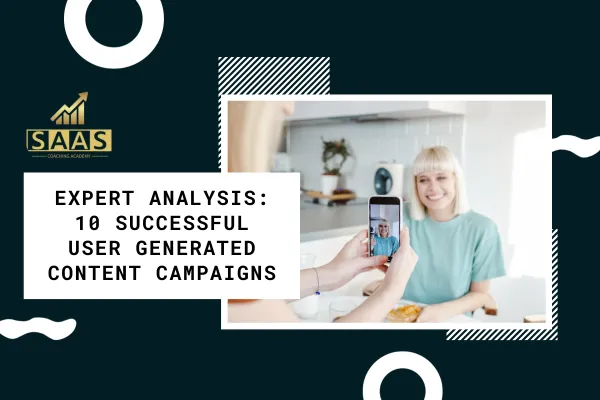Exciting Insights and Tips on Digital Marketing, Sales, Hustle Life, Customer Service, and Upcoming AI

10 Successful User Generated Content Campaigns: Expert Analysis Included
The Power of User-Generated Content in Increasing Brand Awareness
In today's digital age, user-generated content (UGC) has become a powerful tool for businesses to enhance their brand awareness and connect with their target audience. UGC refers to any content, such as photos, videos, reviews, or testimonials, that is created and shared by consumers about a brand or its products. This content is often shared on social media platforms, websites, or other online channels.
According to a survey conducted among marketers, a staggering 92% believe that UGC is effective in boosting product visibility. This statistic highlights the significant impact that UGC can have on a brand's reach and recognition. By leveraging content created by their own customers, businesses can tap into the authenticity and trust that comes with peer recommendations.
One of the key advantages of UGC is its ability to provide a continuous marketing opportunity. Unlike traditional advertising campaigns that have a limited lifespan, UGC can be generated and shared by consumers on an ongoing basis. This means that brands can benefit from a steady stream of content that showcases their products or services in real-life situations.
Moreover, UGC allows brands to engage with their customers in a more meaningful way. By encouraging consumers to share their experiences and opinions, brands can foster a sense of community and loyalty among their customer base. This not only strengthens the relationship between the brand and its customers but also creates a sense of authenticity and credibility.
In the following sections, we will explore some impressive examples of UGC campaigns from various brands, as well as expert tips for creating successful UGC campaigns. These examples and insights will provide valuable guidance for businesses looking to harness the power of UGC to increase their brand awareness and engage with their target audience effectively.

Impressive UGC Campaigns from Various Brands
User-generated content (UGC) has become a powerful tool for brands to engage with their customers and increase brand awareness. Many brands have successfully implemented UGC campaigns, leveraging the creativity and authenticity of their customers to create impactful marketing initiatives. Here are some examples of impressive UGC campaigns from various brands:
1. Sephora: Sephora, a renowned beauty retailer, has embraced UGC by featuring real customers in an interactive gallery on their website. Customers can upload their makeup looks and share their experiences with Sephora products. This not only encourages customers to engage with the brand but also provides valuable social proof for potential buyers.
2. Farrow & Ball: Farrow & Ball, a luxury paint and wallpaper brand, showcases UGC to inspire interior designers and homeowners. They encourage customers to share photos of their beautifully decorated spaces using Farrow & Ball products. By featuring these images on their website and social media platforms, Farrow & Ball creates a sense of community and demonstrates the versatility of their products.
3. The Cosmopolitan of Las Vegas: The Cosmopolitan of Las Vegas, a popular hotel and casino, leverages UGC from guests on its website. They encourage guests to share their experiences and photos using a specific hashtag. By showcasing these images on their website, The Cosmopolitan of Las Vegas provides potential guests with an authentic glimpse into the hotel experience.
4. Article: Article, an online furniture retailer, utilizes UGC to engage with their customers. They encourage customers to share photos of their Article furniture on social media using a designated hashtag. Article then features these images on their website, allowing potential buyers to see how the furniture looks in real homes.
5. Vitamix: Vitamix, a high-performance blender brand, incorporates UGC into their marketing strategy. They encourage customers to share their favorite recipes and photos of their creations using the Vitamix blender. By featuring these recipes and images on their website and social media platforms, Vitamix not only engages with their customers but also provides inspiration for others.
6. Crocs: Crocs, a popular footwear brand, embraces UGC by encouraging customers to share their Crocs moments on social media. They feature these images on their website and social media platforms, showcasing the versatility and comfort of their products.
7. Revel Nail: Revel Nail, a nail dip powder brand, leverages UGC to showcase their products. They encourage customers to share photos of their manicures using Revel Nail products. By featuring these images on their website and social media platforms, Revel Nail provides potential customers with inspiration and demonstrates the quality of their products.
8. Jones Soda: Jones Soda, a beverage company, incorporates UGC into their product packaging. They encourage customers to submit their photos, which are then featured on the labels of Jones Soda bottles. This unique approach not only engages customers but also creates a personalized and memorable experience.
9. Northumbria University: Northumbria University utilizes UGC to showcase student experiences and campus life. They encourage students to share their photos and stories using a designated hashtag. By featuring these images and stories on their website and social media platforms, Northumbria University provides prospective students with an authentic glimpse into university life.
10. NAVY Hair Care: NAVY Hair Care, a haircare brand, incorporates UGC into their marketing strategy. They encourage customers to share their hair transformations and experiences using NAVY Hair Care products. By featuring these images and stories on their website and social media platforms, NAVY Hair Care not only engages with their customers but also provides social proof for potential buyers.
These examples demonstrate the effectiveness of UGC campaigns in engaging with customers and increasing brand awareness. By leveraging the creativity and authenticity of their customers, brands can create a sense of community, provide social proof, and inspire others. In the next section, we will explore tips from Emplifi's Chief Strategy Officer, Kyle Wong, on how to create a successful UGC campaign.

Tips for Creating a Successful UGC Campaign
In order to create a successful user-generated content (UGC) campaign, it is important to follow certain strategies and best practices. Emplifi's Chief Strategy Officer, Kyle Wong, shares five tips for creating an effective UGC campaign.
1. Collect and Store Positive Customer Stories: The first step in creating a successful UGC campaign is to collect and store positive customer stories. Wong emphasizes the importance of actively seeking out and documenting customer experiences and testimonials. This can be done through various means such as feedback forms, surveys, or even by monitoring social media mentions. By collecting these stories, brands can showcase the positive impact their products or services have had on customers, which can in turn boost brand awareness and credibility.
2. Amplify UGC Through Various Channels: Once positive customer stories have been collected, Wong suggests amplifying them through various channels. This can include sharing UGC on social media platforms such as Instagram, Facebook, or Twitter. Brands can also create dedicated landing pages or sections on their website to showcase UGC. By making UGC easily accessible and visible to a wider audience, brands can increase their reach and engagement.
3. Include a Call-to-Action for Customers: Wong emphasizes the importance of including a call-to-action for customers in UGC campaigns. This can be in the form of encouraging customers to share their own experiences or testimonials, or by asking them to participate in contests or challenges related to the brand. By actively involving customers in the UGC campaign, brands can foster a sense of community and loyalty, while also generating more content.
4. Use UGC to Inform Product Lines and Marketing Positioning: UGC can provide valuable insights into customer preferences and behaviors. Wong suggests using UGC to inform product lines and marketing positioning. By analyzing the content generated by customers, brands can gain a better understanding of what resonates with their target audience and tailor their products and marketing strategies accordingly. This can lead to more effective and targeted campaigns.
5. Address Legal Issues Related to UGC Campaigns: Lastly, Wong advises brands to address any legal considerations related to UGC campaigns. This includes obtaining proper permissions and releases from customers before using their content, ensuring compliance with copyright laws, and being transparent about how customer content will be used. By addressing legal issues upfront, brands can avoid potential pitfalls and protect both themselves and their customers.
In conclusion, creating a successful UGC campaign requires careful planning and execution. By following these tips from Kyle Wong, brands can harness the power of user-generated content to increase brand awareness, engage with customers, and inform their marketing strategies.

Collecting and Storing Positive Customer Stories
In order to create a successful user-generated content (UGC) campaign, it is crucial to have a repository where positive customer stories can be collected and stored. This repository serves as a valuable resource for brands to showcase the positive experiences and feedback from their customers.
Kyle Wong, Chief Strategy Officer at Emplifi, emphasizes the importance of offering diverse options for customers to leave reviews and share their stories. This can be done through feedback forms, testimonial pages on the brand's website, and actively engaging with customers on social media platforms.
By providing these opportunities for positive feedback, brands can gather a wealth of UGC that can be used to enhance their marketing efforts. These customer stories can be powerful tools in building brand credibility and trust, as they come directly from real customers who have had positive experiences with the brand.
Having a repository to collect and store these stories is essential for easy access and organization. It allows brands to easily search and retrieve UGC that aligns with specific marketing campaigns or initiatives. This repository can also serve as a source of inspiration for future marketing strategies, as brands can analyze the common themes and sentiments expressed by their customers.
Additionally, Wong highlights the importance of actively engaging with customers on social media. By being responsive and interactive on platforms like Instagram, Twitter, and Facebook, brands can encourage customers to share their experiences and stories. This not only helps in collecting UGC but also fosters a sense of community and loyalty among customers.
In conclusion, having a repository to collect and store positive customer stories is crucial for a successful UGC campaign. By offering diverse options for customers to leave reviews and actively engaging with them on social media, brands can gather valuable UGC that can be used to enhance their marketing efforts and build trust with their audience.

Amplifying User-Generated Content
In order to fully harness the power of user-generated content (UGC), it is crucial to amplify it through various channels. By doing so, brands can maximize the reach and impact of UGC, ultimately increasing brand awareness and engagement. Emplifi's Chief Strategy Officer, Kyle Wong, provides valuable insights on how to effectively amplify UGC.
One of the most effective ways to amplify UGC is through social media. Wong suggests sharing UGC on platforms such as Instagram, Facebook, and Twitter, where brands can reach a wide audience. By featuring UGC on social media, brands not only showcase the positive experiences of their customers but also encourage others to engage with their products or services.
Creating dedicated landing pages or sections on the brand's website to showcase UGC is another powerful strategy. This allows potential customers to see real-life examples of how others have interacted with the brand, building trust and credibility. By prominently displaying UGC on the website, brands can inspire and influence visitors, ultimately driving conversions.
To further associate UGC with the brand, Wong recommends using specific hashtags or tags. This helps to create a sense of community and affiliation with the brand, making it easier for users to find and engage with UGC. By encouraging customers to use these hashtags or tags when sharing their experiences, brands can easily track and curate UGC for future use.
One significant advantage of UGC is its ability to drive social sharing. When customers see their content being featured by a brand, they are more likely to share it with their own networks. This not only expands the reach of UGC but also increases brand visibility and credibility. By leveraging UGC to drive social sharing, brands can tap into the power of word-of-mouth marketing.
Moreover, UGC can provide valuable insights that inform product strategies and market positioning. By analyzing the content generated by customers, brands can gain a deeper understanding of their target audience's preferences, needs, and desires. This information can then be used to refine product lines, develop new offerings, and tailor marketing campaigns to better resonate with customers.
Lastly, Wong advises addressing any legal considerations related to UGC campaigns. It is important to ensure that the use of UGC complies with copyright laws and that proper permissions are obtained from the content creators. By proactively addressing legal issues, brands can avoid potential disputes and maintain a positive brand image.
In conclusion, amplifying user-generated content is essential for maximizing its impact and reaping its benefits. By sharing UGC on social media, creating dedicated website sections, using specific hashtags or tags, and encouraging social sharing, brands can increase brand awareness and engagement. Additionally, UGC can inform product strategies and market positioning, providing valuable insights into customer preferences. However, it is crucial to address any legal considerations to ensure a smooth and compliant UGC campaign.



© 2025 SaaS Coaching Academy | All Rights Reserved | All Sales Are Final No Refunds | Privacy Policy | Terms of Service | Contact Us
info@leadstoroi.com
541-270-3477

